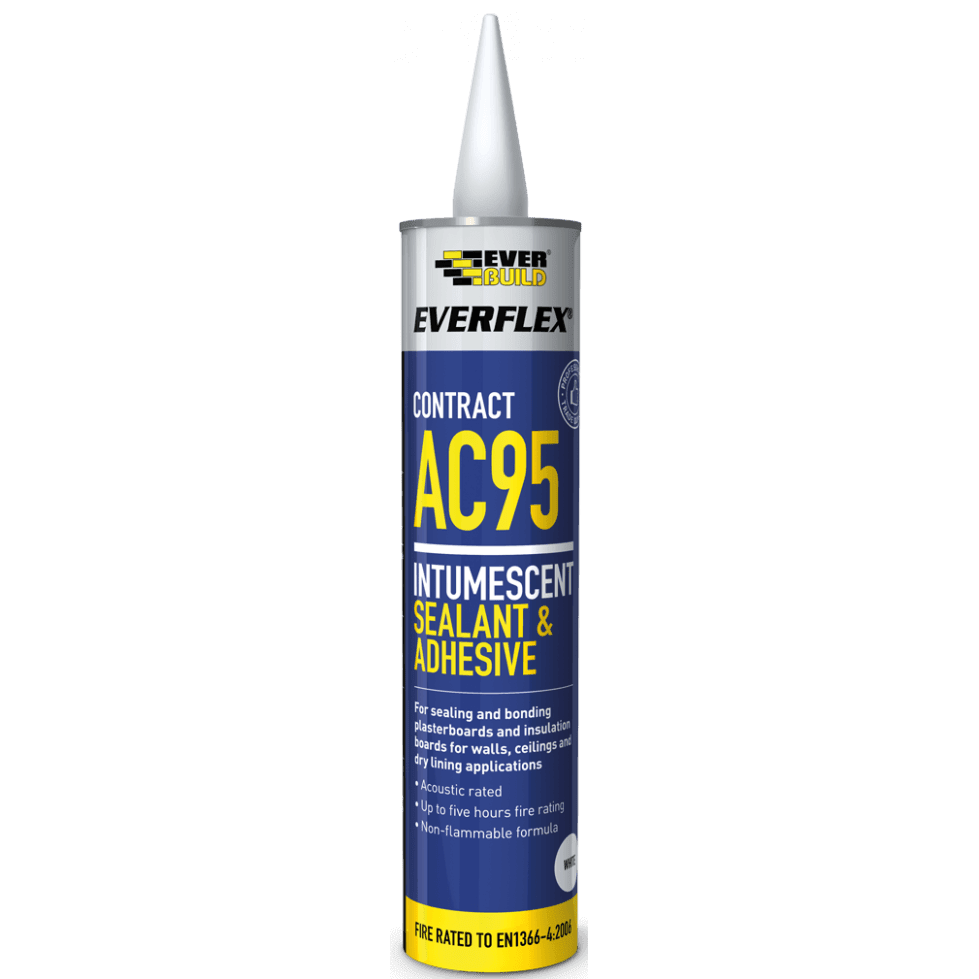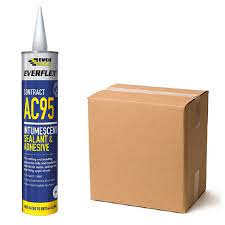Silicone & Sealants
(37 Products)Sealants are designed to fill and seal gaps or joints, creating a durable, protective barrier against water, air, and debris. Our extensive range from the trusted Everbuild brand offers a reliable solution for any project. We carry specialist formulas, including general-purpose and mould-resistant options for wet areas, as well as high-performance fire and heat-resistant sealants, all available in standard, sealant gun-compatible cartridges.
What is a Sealant?
A sealant is a material used to block the passage of fluids, air, or other substances through openings or joints in materials. While some are rigid, most are engineered to be flexible, allowing them to accommodate movement between different building components without cracking or losing adhesion.
The primary functions of a sealant are to:
- Waterproof: Prevent water ingress in areas like bathrooms, kitchens, and exterior joints.
- Weatherproof: Protect against rain, wind, and UV radiation in outdoor applications.
- Provide Flexibility: Accommodate natural expansion and contraction of building materials.
- Fill Gaps: Create a clean, aesthetic finish over gaps and cracks.
- Provide Specialist Protection: Offer specific properties such as fire resistance or mould prevention.
In the UK and Europe, sealants are classified by the BS EN 15651 standard, which certifies their suitability for different applications, such as for facades (exterior walls), sanitary joints, or glazing.
Types of Sealants
While there are many specialist formulations, most sealants can be grouped into several key categories based on their intended application.
General Purpose Sealants
These are the versatile, everyday products designed for simple interior filling and sealing tasks where high flexibility or extreme weather resistance is not a priority.
Often based on acrylic polymers, they are easy to apply and can be painted over, making them ideal for sealing gaps around skirting boards, architraves, and window frames before decorating.
- Primary Use: Interior gap-filling and decorating.
- Key Properties: Paintable, low odour, easy to tool.
Shower & Bath Sealants (Sanitary Sealants)
This is a specialist category of sealant, almost always silicone-based, designed for high-humidity environments. Its critical feature is the inclusion of a powerful fungicide, which actively resists the growth of mould, mildew, and bacteria.
These "sanitary" grade sealants provide the necessary flexibility to accommodate movement, preventing cracks and leaks. They typically use an acetoxy cure system, which releases a characteristic vinegar-like smell as it cures.
- Primary Use: Sealing around baths, shower trays, sinks, and kitchen worktops.
- Key Properties: 100% waterproof, excellent mould resistance, durable finish.
Building & Roofing Sealants
Designed for demanding exterior applications, these sealants offer superior performance characteristics. They are engineered for high movement accommodation, allowing them to expand and contract with temperature changes without failing.
They also have excellent adhesion to a wide range of construction materials and high resistance to UV radiation and weathering. These are often based on "neutral cure" silicone or other advanced polymers, which have a lower odour and offer better adhesion to metals and plastics.
- Primary Use: Sealing exterior window and door frames, expansion joints, guttering, and roofing components.
- Key Properties: High flexibility, excellent weather and UV resistance, strong adhesion.
Intumescent Sealants (Fire Stopping)
Intumescent sealant is a specialist product used as part of a building's passive fire protection system. In the event of a fire, the sealant is designed to swell or expand dramatically when it reaches a certain temperature.
This expansion seals gaps and joints in walls and floors, preventing the passage of fire and smoke from one compartment to another for a specified period (e.g., up to 4 hours). It is a critical component for sealing around pipes, cables, and construction joints in fire-rated walls.
- Primary Use: Fire stopping gaps and linear joints in fire-rated structures.
- Key Properties: Expands in heat to block fire and smoke, provides acoustic insulation.
Considerations for Application
- Preparation is Everything: The single most important factor for a successful seal is a clean, dry, and dust-free surface. Use cleaning spirits or alcohol wipes to remove any soap scum, grease, or old sealant residue before you begin.
- Use a Primer (If Required): For difficult surfaces like some plastics or porous stone, a specialist primer may be needed to ensure proper adhesion.
- Tooling for a Professional Finish: Immediately after applying the sealant, smooth the bead using a sealant finishing tool or a wet finger dipped in a mild soap solution. This creates a neat, compressed seal that adheres correctly to both surfaces.
- Observe Curing Times: All sealants need time to "cure" and develop their final properties. Do not expose a newly sealed area to water until it has fully cured, as per the manufacturer's instructions.
Frequently Asked Silicone & Sealants Questions
What Is The Difference Between "Acetoxy Cure" And "Neutral Cure" Silicone?
This refers to the chemical process the silicone uses to cure (harden).
- Acetoxy cure silicones release acetic acid as they cure, which often gives them a strong, vinegar-like smell. They are fast-curing and adhere very well to smooth surfaces like glass and ceramic, making them ideal for sanitary applications.
- Neutral cure silicones release alcohol as they cure, have very little odour, and offer better adhesion to a wider range of materials, including plastics, metals, and masonry. They are the standard choice for exterior building and roofing jobs.
What Does "Low Modulus" vs "High Modulus" Sealant Mean?
"Modulus" refers to the sealant's elasticity or stiffness once cured. A low-modulus sealant is soft, highly flexible, and can stretch a lot, making it ideal for joints that experience a lot of movement (like between a lightweight acrylic bath and a tiled wall).
A high-modulus sealant is more rigid, tough, and less flexible, making it suitable for joints where durability is key and very little movement is expected.
Why Has My Clear Silicone Sealant Turned Yellow?
Clear silicone sealant can sometimes yellow over time, particularly lower-quality formulations. This is often caused by a reaction to UV light exposure, even indirect sunlight through a window.
Using a high-quality, modern silicone with UV stabilisers will significantly reduce the chances of this happening.
My New Sealant Isn't Drying or Feels Sticky After 48 Hours. What's Wrong?
This usually indicates a problem with the curing process. The most common causes are an expired sealant cartridge (always check the date) or applying it in very cold or dry conditions.
Most silicones rely on atmospheric moisture to cure properly, so if the air is exceptionally dry and cold, the curing time can be extended significantly.
Are Silicone Sealants Waterproof?
Yes, silicone sealants are waterproof and can be used in areas that are exposed to water, such as bathrooms and kitchens.
How Long Does It Take For Silicone Sealant To Dry?
The drying time of silicone sealant can vary depending on the formulation and conditions in which it is applied. Typically, it can take between 24 and 48 hours for silicone sealant to fully cure.
Can Silicone Sealants Be Used On All Surfaces?
No, silicone sealants are not suitable for all surfaces. It is important to check the manufacturer's instructions to ensure that the sealant is compatible with the surface you plan to use it on. To find the best silicone sealant for your project please refer to the datasheets on each product page.
How Do You Remove Silicone Sealant?
Silicone sealant can be removed using a silicone sealant remover or a scraper tool. It is important to follow the manufacturer's instructions and take proper safety precautions when removing silicone sealant.













